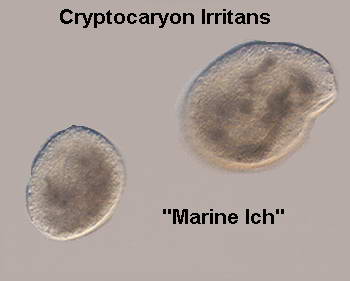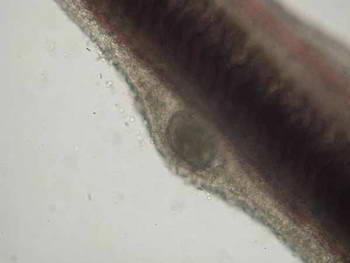



The life cycle and time line of each stage:
1 : TOMONT STAGE: This is where the parasite forms a membrane while attached to the substrate and goes into its reproductive mode, this can take from 3 to 28 days depending on the temperature of the water.
2 : THERONT STAGE: This is where the newly hatched parasite is free swimming in the water and is looking for a fish to attach to. It only has between 24 to 48 hours to do so or else it will die.
3 : TROPHONT STAGE: This is the adult parasite which is attached to a fish and actively feeding and the one that we can visibly see on a fish. This stage lives from 3 to 7 days.
4 : TROPHONT FREE SWIMMING: This is where the parasite has dropped off of the fish and is free swimming within the water looking for a suitable place to attach to so that it can form itself into the Tomont or reproductive stage, which can take up to 18 hours.

So now what are we supposed to do with that bag of water and the fish or sand/rock that we are so proudly holding? PUT IT IN A QUARANTINE TANK!!!! yes, even the sand and rocks, anything that came from another tank should be quarantined. Here is a link that will guide you in what is needed and how to set up and use a QUARANTINE TANK.
1. Set up and have ready your quarantine tank filled with your tank's water.
2. Catch and place ALL of your fish into the quarantine tank.
3. Adjust the salinity as per what you read in the hypo salinity article with the use of a refractometer, if one is not available, then treat the quarantine tank with a medicated / chemical treatment method.
4. What is happening to the parasite now that it is trapped in a tank with nothing but fish and a low salinity level. Over the course of the first week, most, if not all of the adult parasites that are on the fish will reach the stage where they must drop off of the fish and go into their reproductive stage. This is where we catch them with their pants down. As the adults swim to the bottom of the tank and anchor themselves, they will form a membrane surrounding themselves in order to reproduce, which they do by division, much like a bacteria does. But the problem is, they are unable to do so at lowered salinity levels since they rely on the osmotic pressure difference (salinity differences) between normal sea water levels and what is formed within their membrane to pass what they need from the outside world through their membrane, in short, since the salinity levels within the membrane and outside the membrane are almost equal, there is no pressure difference to allow any transfer of liquids. In short, they smother to death and are unable to start their division process. They may even be totally unable to form a membrane to start with. With that done, we have broken their life cycle. No possible "babys" that can attach to the fish and start the cycle all over again.
5. If you add up the time of these cycles, you will note that the fish should be clear of the parasite in a little over a week. Are we now going to put the fish back?...NO!!!, to do so now would just infect the fish all over again. The parasite is still in your aquarium. So lets deal with that now. Actually you already have been dealing with that since you first removed the fish. Here is why:
1. This is the easy part. By having no fish in the tank, we can let the tank just go about its daily routine. we can feed the corals, and do our normal tank maintenance.
2. With no fish in the tank, any Tomonts that hatch will not have any fish to attach to and start feeding to grow into adults...........No fish = starving baby Ich.
3. The reason the tank must remain without fish for 6 weeks, is that the Tomont stage can take up to 28 days to hatch out, if it is a different species, it could take longer. With this being the longest stage of the parasite, it will take the longest to "cure". Note that I said 6 weeks and not 28 days. This is just being on the safe side. Why wait exactly 28 days only to find out the hard way that it may have taken a bit longer. Or that it may just well be a different species of this parasite.
MARINE ICH LOOK ALIKES
I have seen on numerous occasions that some hobbyists, no matter what they do, seem never able to defeat what they think is the Ich parasite. Even after ten to twelve weeks of hyposalinity treatment within a quarantine tank, and leaving the main tank to lay fallow (fishless), they still encounter what appears to be Ich once the fish are introduced back into the main tank. As such, this lead me to investigate the possibility that there may be other fish parasites that also appear as "white specks" on fish. Besides having trouble eradicating what is thought to be marine Ich, I also began to wonder how it is possible that with a great number of possible fish parasites, that only the Ich parasites seems to make its way all the way across the ocean during shipment from overseas. If the Ich parasite can hitch a ride during shipment, then surely, any other parasite can do so as well.
 If I were to see this on a fish, at normal distances and with the
constant movement of the fish, I would naturally assume, Ich! But these are a crustaceamorpha, most likely any number
of parasitic copepods. Of which, just within the Copepods there
are 10,000 species worldwide;(that are known), 2000 parasitic
species, 90% of these are marine, 20% of these on fishes and
elasmobranches, rest on inverts (Mytilicola intestinalis in oysters), and that just details possible copepod species!! Toss in all other possible
parasites and their life cycles, and it becomes quickly apparent that "little
white dots" could be a great number of "things". A good many species having
quite differing life cycles than that of the "Ich" parasite. Which may (or may
not) explain why standard hyposalinity / tank fallow methods may not work on
every "white dot". A good many of the adults are free swimming and have no need
of fish as a host, only their infectious young do so. Life spans are also a lot
longer as well. I have seen 1 to 9 years being mentioned!!!
If I were to see this on a fish, at normal distances and with the
constant movement of the fish, I would naturally assume, Ich! But these are a crustaceamorpha, most likely any number
of parasitic copepods. Of which, just within the Copepods there
are 10,000 species worldwide;(that are known), 2000 parasitic
species, 90% of these are marine, 20% of these on fishes and
elasmobranches, rest on inverts (Mytilicola intestinalis in oysters), and that just details possible copepod species!! Toss in all other possible
parasites and their life cycles, and it becomes quickly apparent that "little
white dots" could be a great number of "things". A good many species having
quite differing life cycles than that of the "Ich" parasite. Which may (or may
not) explain why standard hyposalinity / tank fallow methods may not work on
every "white dot". A good many of the adults are free swimming and have no need
of fish as a host, only their infectious young do so. Life spans are also a lot
longer as well. I have seen 1 to 9 years being mentioned!!!
In summary, if you find yourself facing an Ich parasite that
seems to refuse to die, I would fall back on copper based treatments to
ensure what ever that "white dot" is, it will be dealt with. For more
information on the possible fish parasites, please see this link which
is in .PDF format and you will need the adobe acrobat reader if you do
not already. Crustaceamorpha Parasites
1. Quarantine EVERYTHING!!..the fish, the rock, the sand, the corals, EVERYTHING!...remember, we are not just looking for the Ich parasite, we are also trying to prevent other diseases, other parasites of both fish and corals, and unwanted life forms such as mantis shrimp or aiptasia anemone. By having each and everything go into a separate tank for no less than 6 weeks, it gives us time to check over each item for ANY problems while killing a possible unseen Ich parasite.
2. Treat all fish in quarantine with hypo salinity for no less than 4 weeks, which means DO NOT add anything in with quarantined fish that can not survive hypo salinity such as corals and most inverts. If you do not want to set up two quarantine tanks, then space out your purchases to avoid mixing them.
3. ANYTHING that can not be treated with hypo salinity must remain in quarantine for no less than 6 weeks with NO FISH present. Remember, we have to break one of the cycles to be rid of it.
4. NO FISH = no place for the babys to grow into adults. Takes 6 weeks.
5. FISH PLUS HYPO SALINITY = Kill the babys and also deny the adults the chance to reproduce. Takes 4 weeks.
6. There are different species of this parasite, some are more susceptible to treatment than others, it is impossible for us to know which one that could be infecting our tanks, which is why I have to stress that any treatment performed be done at the maximum time suggested, to rush any method is just inviting failure.
While ALL the fish are in the quarantine tank, DO NOT add anything to the main tank, which means, no rocks, no sand, no inverts, by doing so, you could be adding the reproductive encystments to your main tank which can take up to a month to hatch out. And when they do, they will most likely have newly treated ich free fish to attack. This is probably why the myth that this parasite is always in the tank still persists to this day. Everything you add to the tank should be kept in quarantine. If it is not a fish, put it in quarantine for six weeks with no fish. If it is a fish, put it in quarantine and treat for the parasite whether you see it on the fish or not.
# 1 - It is always in the tank - This would be funny if it was not such a common belief, While it may be true that this parasite is always in your tank, not because there is nothing we can do about it, but that so few of us understand this parasites life cycle and how fish may react to it. While some treatments may reduce their numbers and that some fish may develop a resistance to the parasite, it may seem that the parasite is gone, only to make a come back weeks or months later, leaving us confused as to how it got back in the tank, of which then some of us make the assumption that it is always in the tank, which may have been true, but not for the reason usually believed. We either put it right back in the tank from not using proper quarantine procedures or a treatment method fooled us into believing it is gone while being able to remain on a fish that has developed a resistance to it. This lack of understanding has even given rise to a "theory" that Ich has gained the ability to become airborne in an attempt to explain why it is always in our tanks. Of course, this is nonsense.
# 2 - Immunity / Resistance - Some fish are more susceptible to ich than others … often directly associated with the thickness of the mucus lining or type of scales on the fish. Some fish like Tangs are known as ich magnets – probably because of the lack of scales. Some fish like Mandarin’s are considered highly resistant to ich – probably because of the thick mucus lining. Being less susceptible to ich does not necessarily make them immune from ich … Mandarins as examples are less likely to be infected – but they can be infected and have been known to die from ich. Experts believe that fish that have been exposed to ich can develop some level of immunity to fend off future attacks. The defense mechanism allowing them to fend off future attacks is not fully understood and is often discussed in the context of immunity. Sometimes the fish can develop a total resistance to the parasite … and those fish are considered to have developed total immunity. Often a fish can develop partial resistance to future attacks which is often referred to as partial immunity - the range of partial immunity is apparently very broad with some fish showing nominal resistance while other fish can show significant resistance. If all fish in the tank develop full immunity then the ich cycle is effectively broken. If even one fish in the tank has partial immunity then that fish will be the vehicle which allows ich to continue its life cycle. Immunity … whether total or partial, it apparently does not last forever … there is no agreement on how long a fish can remain immune. Perhaps some of our human vaccinations may be an appropriate analogy.. Not sure. Partial immunity is thought to be one of the reasons that many experienced aquarist believe that ich exist in all tanks. A fish with significant resistance to ich may carry a nominal infestation which can easily go unnoticed on the fish. The ich can continue it life cycle within the tank to surface at a later date - perhaps when a new fish is introduced into the tank – perhaps when the existing fish loose there immunity - often associated with a stress event which may have an impact on the overall immune system of the fish (reducing or eliminating the ich immunity??).
# 3 - UV Filters - Sorry, I believe these devices do not help at all with defeating this parasite, the sheer volume of theronts being hatched out still allows plenty of parasites to find themselves a home on a fish, long before they happen to end up going through a filter. While they may, and I stress MAY, reduce the numbers of free swimming stages, the filter alone will not rid the tank of the parasite. I believe the misconception of the effectiveness of this piece of equipment stems from not knowing the life cycles of this parasite and the numbers that can be involved. For me, a UV filter is just a "feel good" device and leads hobbyists into a false sense of security.
# 4 - Cleaner fish and shrimp - Again, not effective, for one, cleaner wrasse have not been shown to eat this parasite at all. I am not sure why they will not, but it may have to do with how deeply the parasite embeds itself into the fish. As far as cleaner shrimp, again, I know of nothing to date that shows they also eat this parasite or not. But for the sake of argument, lets say they did, they would still be ineffective, if you have ever seen a cleaning session between a cleaner and a fish, you would notice right away that they are not very good at cleaning the entire fish at one time, and keeping in mind that all it takes is one adult parasite to detach and make it to the sand bed to reproduce, then I would not want to bet my fish on a sloppy eater. Along with the fact that this parasite will also embed deeply in the gills, even a good cleaning would still leave enough adults behind to carry on the family name.
# 5 - Other treatment methods - While there are a few other methods to kill this parasite, such as copper and other "medications", they fail to address our needs as coral reef hobbyists, copper itself may kill the parasite but can not be used in our tanks since it will kill all our corals and inverts as well. While this treatment method may be effective in a quarantine tank, most hobbyists again fail to realize that the parasite is still within the tank itself. After a week of copper treatment, the fish is usually placed right back into the aquarium only to become infected again. Remember this parasites life cycle and why we must leave the aquarium without fish for six weeks. Any treatment that removes the fish from the aquarium and kills the parasite is doomed to failure if the aquarium itself is allowed to have fish remaining within it or the treated fish is placed back into the tank before the tank's 6 week period of having no fish within it. So why subject any of our fish to copper, which can be lethal also, when all the fish are going to have to remain outside the main tank for 6 weeks anyways, we might as well use a far less stressful method (hypo salinity) during that 6 week period.
Reef safe medications - There are plenty of products claiming to be effective against this parasite while in the presence of other inverts and corals. Most are ineffective for a few reasons. They are either diluted to the point that they cause corals no long term harm and may temporarily suppress one of the parasites life cycles, and for awhile, the tank may appear to be Ich free only to have it reappear again. The makers of these treatments fail to take into account that the adult parasite embeds deeply into the fish and its mucus covering, thus affording it some protection against external treatment methods. While embedded, this parasite may be invisible to us. Given this, along with the fact that the population of Ich may have been reduced, giving the impression that it is gone, again, remembering its life cycle, all it takes is a Tomont or an adult parasite to have survived the week or two of treatment to be able to start a new population. While its numbers slowly increase, it is at this time that we think our tanks are Ich free and when they do become a large enough population to become visible again, we can fall into that trap of assuming they are just always in the tank no matter what we do. It is for all of the above reasons that I firmly believe that the hypo salinity method is our best and at times, only option. A fishes own resistance to the parasite may also be mistaken as a reef safe medication having worked. All it takes though is for a stress event to occur within the tank, and the fish may lose their resistance allowing the parasite to make a full come back.
Wild Fish always have it so what is the big deal? - Well, going back to the life cycles of the parasite, an adult parasite on a fish in the wild will drop off after seven days or so of feeding on the fish to enter its reproductive mode, given the expanse of the ocean, how likely is it that the offspring that hatch out are likely to encounter the same fish again? Where as in our enclosed little boxes, when those offspring hatch out, they have a readily available fish that is not going very far at any time soon, and is most likely the same fish their daddy was on as well. With the fish enclosed or trapped amongst hundreds if not thousands of free swimming, ready to attack parasites, you can see the problem in thinking that a wild fish in the ocean deals with the same problems as our captive kept specimens.
Well, I hope to have at least taught you what it takes to be rid of this parasite once and for all, you just have to decide that you WILL NOT add anything at all to your tank unless it has been through a quarantine period. I can not stress the importance of this enough.